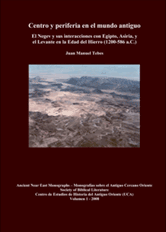Juan Manuel Tebes, Centro y periferia en el mundo antiguo. El Negev y sus interacciones con Egipto, Asiria, y el Levante en la Edad del Hierro (1200-586 a.C.)
Ancient Near East Monographs 1 | 2nd ed | Society of Biblical Literature & CEHAO | 2008 | ISBN-10: 950440068X | ISBN-13: 9789504400684 | 111 pages | PDF | 5,09 MB
Ancient Near East Monographs 1 | 2nd ed | Society of Biblical Literature & CEHAO | 2008 | ISBN-10: 950440068X | ISBN-13: 9789504400684 | 111 pages | PDF | 5,09 MB
This book investigates the socioeconomic structure of the Negev, the arid periphery located in the south of the modern state of Israel, in the Late Bronze and Early Iron Ages (ca. 1300–586 B.C.). During the first millennium B.C. the Negev passed through a series of socio-political and economic fluctuations inextricably related to changes occurring in the Iron Age world-system. A world-system perspective demonstrates that the local, essentially tribal society, evolved through a series of phases of chiefdom-formation and posterior dissolution. Interrelated political events and economic factors that had long-lasting impact on the autochthonous tribal groups need to be seen under the light of these systemic interactions. The main cause that triggered the local chain of events were the unequal exchange relations between the contemporaneous states—particularly pharaonic Egypt and Assyria, but also tiny Levantine states such as Judah—and the Negev tribal organizations.



